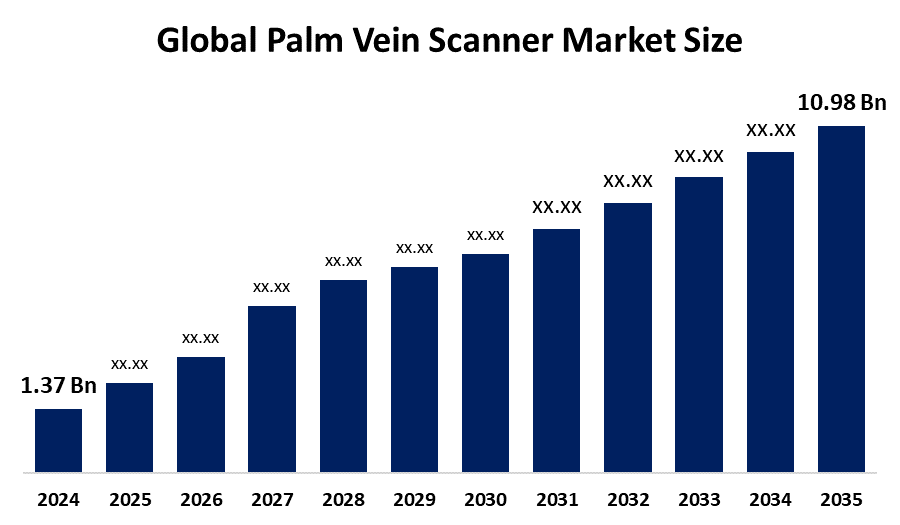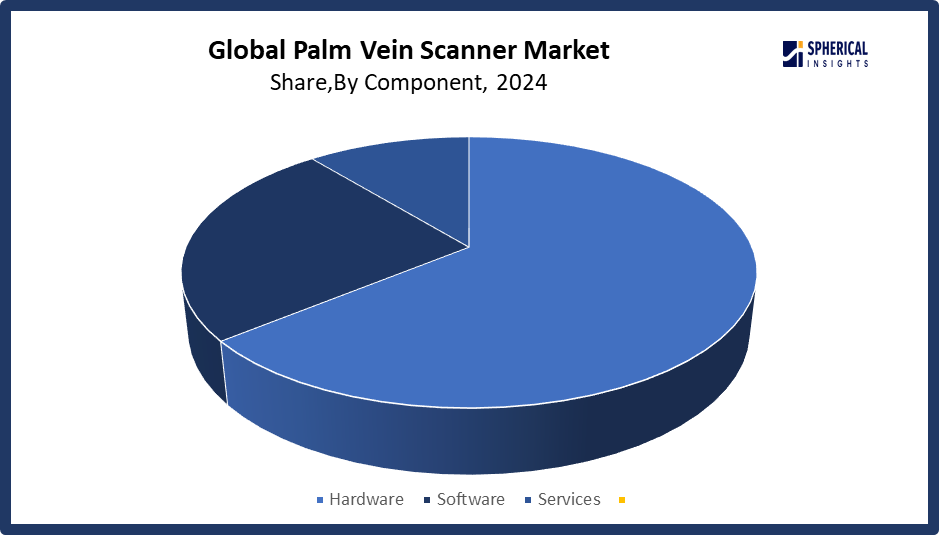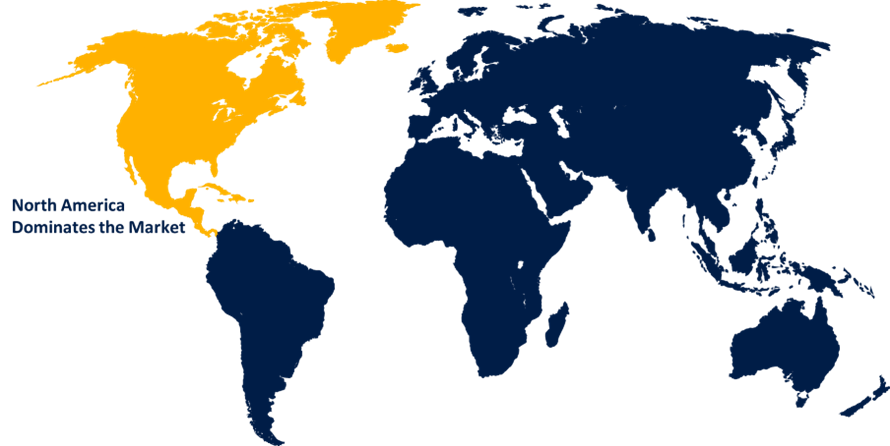Global Palm Vein Scanner Market Size, Share, and COVID-19 Impact Analysis, By Component (Hardware, Software, and Services), By Technology (Optical Imaging, Infrared Imaging, and Hybrid Imaging), and By Region (North America, Europe, Asia-Pacific, Latin America, Middle East, and Africa), Analysis and Forecast 2025 - 2035
Industry: Chemicals & MaterialsGlobal Palm Vein Scanner Market Insights Forecasts to 2035
- The Global Palm Vein Scanner Market Size Was Estimated at USD 1.37 Billion in 2024
- The Market Size is Expected to Grow at a CAGR of around 20.83% from 2025 to 2035
- The Worldwide Palm Vein Scanner Market Size is Expected to Reach USD 10.98 Billion by 2035
- Asia Pacific is expected to grow the fastest during the forecast period.

Get more details on this report -
According to a research report published by Spherical Insights and Consulting, The Global Palm Vein Scanner Market Size was worth around USD 1.37 Billion in 2024 and is predicted to grow to around USD 10.98 Billion by 2035 with a compound annual growth rate (CAGR) of 20.83% from 2025 and 2035. The market for palm vein scanner has a number of opportunities to grow because of the growing need for safe, contactless biometric authentication, the growing use of biometrics in the banking, healthcare, and government sectors, the development of imaging technology, and the global focus on data security and fraud prevention.
Market Overview
A palm vein scanner is a biometric tool that uses near infrared light to identify each person's distinct vein patterns in their hand. The market is expanding as a result of ongoing advancements in palm vein recognition technology, which greatly increase scanning system accuracy, speed, and integration. Artificial intelligence and sophisticated algorithms are used in modern systems to improve identification reliability, lower error rates, and speed up processing times. Palm vein scanners are perfect for applications that need rapid and accurate identification verification because of these advancements, which enable real time authentication. Furthermore, there is an increasing amount of interaction with other systems, including enterprise level security platforms, smart home technologies, and mobile devices, which results in smooth user experiences and more system flexibility. Palm vein scanners are getting more versatile and safer as technology develops, which helps them be used more widely in industries including government, finance, and healthcare.
The Dubai Metro Authority intends to install palm recognition gates in place of Nol cards by 2025 as part of smart city projects. It's anticipated that this action will cut boarding times by 40% and increase public transit's overall effectiveness. In December 2019, Recogtech teamed with Nedap, a premier technology specializing in RFID and access solutions, to create a highly secure palm vein recognition technology.
Report Coverage
This research report categorizes the palm vein scanner market based on various segments and regions, forecasts revenue growth, and analyzes trends in each submarket. The report analyses the key growth drivers, opportunities, and challenges influencing the palm vein scanner market. Recent market developments and competitive strategies such as expansion, type launch, development, partnership, merger, and acquisition have been included to draw the competitive landscape in the market. The report strategically identifies and profiles the key market players and analyses their core competencies in each sub-segment of the palm vein scanner market.
Global Palm Vein Scanner Market Report Coverage
| Report Coverage | Details |
|---|---|
| Base Year: | 2024 |
| Market Size in 2024: | USD 1.37 Billion |
| Forecast Period: | 2025-2035 |
| Forecast Period CAGR 2025-2035 : | 20.83% |
| 2035 Value Projection: | USD 10.98 Billion |
| Historical Data for: | 2020-2023 |
| No. of Pages: | 210 |
| Tables, Charts & Figures: | 119 |
| Segments covered: | By Component, By Technology and By Region |
| Companies covered:: | Fujitsu Ltd., Hitachi, Ltd., NEC Corporation, M2SYS Technology, BioSec Group Ltd., Idemia Group, Recogtech B.V., BioEnable Technologies Pvt. Ltd., iDLink Systems Pte Ltd., Mofiria Corporation, Matrix ComSec Pvt. Ltd., ZKTeco Co., Ltd., Mantra Softech Pvt. Ltd., PalmSure, Imprivata, Inc., Others, and |
| Pitfalls & Challenges: | Covid 19 Impact Challenges, Future, Growth and Analysis |
Get more details on this report -
Driving Factors
The palm vein scanner market is driven by the usage of biometrics in banking has grown as customers realize how effective this technology can be as a primary means of identification for financial services like online banking, branch banking, ATM networks, and mobile banking. The medical field also makes use of palm vein biometrics. In the healthcare sector, it offers clear benefits for obtaining and preserving 100% correct patient identity, patient safety, and revenue cycle management. Stadiums, retail establishments, and other commercial locations all use palm vein identification. The BioSec Group's implementation of a biometric palm vein authentication system at the 23,500 seat Hungarian Groupama Arena in July 2017 ended the violence that had previously afflicted football fans.
Restraining Factors
The palm vein scanner market is restricted by factors like the complexity and operational expenses of palm vein scanner systems are increased by the frequent need for professional installation and continuing maintenance. Unlike simpler biometric systems like fingerprint or facial identification, palm vein scanners require skilled professionals to set up and maintain due to their extensive hardware and software integration.
Market Segmentation
The palm vein scanner market share is classified into component and technology.
- The hardware segment dominated the market in 2024, accounting for approximately 64% and is projected to grow at a substantial CAGR during the forecast period.
Based on the component, the palm vein scanner market is divided into hardware, software, and services. Among these, the hardware segment dominated the market in 2024 and is projected to grow at a substantial CAGR during the forecast period. The segment is driven by the growing need for sophisticated hardware elements, including high resolution sensors, imaging systems, and specialist CPUs needed for precise palm vein identification. These hardware elements serve as the scanning systems' backbone, guaranteeing quick, safe, and accurate identification, a crucial feature for a variety of applications in industries including banking, healthcare, and security.

Get more details on this report -
- The optical imaging segment accounted for the largest share in 2024, accounting for approximately 55% and is anticipated to grow at a significant CAGR during the forecast period.
Based on the technology, the palm vein scanner market is divided into optical imaging, infrared imaging, and hybrid imaging. Among these, the optical imaging segment accounted for the largest share in 2024 and is anticipated to grow at a significant CAGR during the forecast period. The dominance is due to the precision and non invasiveness of optical palm vein biometric sensors, which enable identification by capturing the unique look of the palm veins formed by light, providing them a bigger market share than their counterparts. Nevertheless, these methods are quite attractive because of their high resolution and quick processing time, especially for applications in online banking, healthcare, security, etc. Its appeal has been aided by its affordability as compared to other imaging technologies and its adaptability to various lighting conditions. As it grows, optical imaging is expected to maintain a significant market share, particularly in sectors where costs are an issue.
Regional Segment Analysis of the Palm Vein Scanner Market
- North America (U.S., Canada, Mexico)
- Europe (Germany, France, U.K., Italy, Spain, Rest of Europe)
- Asia-Pacific (China, Japan, India, Rest of APAC)
- South America (Brazil and the Rest of South America)
- The Middle East and Africa (UAE, South Africa, Rest of MEA)
North America is anticipated to hold the largest share, representing nearly 36% of the palm vein scanner market over the predicted timeframe.

Get more details on this report -
North America is anticipated to hold the largest share, representing nearly 36% of the palm vein scanner market over the predicted timeframe. In the North America market, the market is rising due to the rapid technical advancements and a growing number of domestic producers. Furthermore, the area is witnessing an increase in business interest in using palm vein scanner devices that identify individuals using biometric traits.
The United States leads the world market for palm vein scanners, mostly because it was the first to adopt cutting edge biometric technologies, made significant investments in security infrastructure, and increasingly used contactless authentication in industries like government identity verification, banking, and healthcare.
Asia Pacific is expected to grow at a rapid CAGR, representing nearly 31% in the palm vein scanner market during the forecast period. The Asia Pacific area has a thriving market for palm vein scanner due to rapid technical advancement, growing biometric system usage, and heightened security awareness in countries like China, India, and Japan are all of which are contributing to the expansion. Growth is being aided by the region's increased digitization as well as the rising demand for secure authentication in industries like banking, healthcare, and government. Furthermore, the need for biometric security solutions in the Asia-Pacific region is being driven by the surge in investments in smart city initiatives.
Competitive Analysis:
The report offers the appropriate analysis of the key organizations/companies involved within the palm vein scanner market, along with a comparative evaluation primarily based on their type of offering, business overviews, geographic presence, enterprise strategies, segment market share, and SWOT analysis. The report also provides an elaborative analysis focusing on the current news and developments of the companies, which includes type development, innovations, joint ventures, partnerships, mergers & acquisitions, strategic alliances, and others. This allows for the evaluation of the overall competition within the market.
List of Key Companies
- Fujitsu Ltd.
- Hitachi, Ltd.
- NEC Corporation
- M2SYS Technology
- BioSec Group Ltd.
- Idemia Group
- Recogtech B.V.
- BioEnable Technologies Pvt. Ltd.
- iDLink Systems Pte Ltd.
- Mofiria Corporation
- Matrix ComSec Pvt. Ltd.
- ZKTeco Co., Ltd.
- Mantra Softech Pvt. Ltd.
- PalmSure
- Imprivata, Inc.
- Others
Key Target Audience
- Market Players
- Investors
- End-users
- Government Authorities
- Consulting And Research Firm
- Venture capitalists
- Value-Added Resellers (VARs)
Recent Development
- In January 2025, Alibaba Accu-Time Systems introduced the stride80 time clock with Only|You Palm vein scan technology, enhancing clock-in efficiency by using unique vascular patterns for superior authentication. This new biometric modality offers faster; more accurate results compared to traditional methods like fingerprints or facial recognition.
- In October 2024, the UAE introduced 'Palm ID' technology, using unique palm vein patterns for secure payments and transactions. Developed by the ICP and Central Bank of the UAE, it is currently in trial phase as part of the UAE Vision 2031 initiative.
- In November 2022, the fundamental technology of NEC’s multimodal biometric authentication brand Bio-Idiom was recognized as the world’s No. 1 in testing for identifying technologies conducted by the US National Institute of Standards and Technology.
Market Segment
This study forecasts revenue at global, regional, and country levels from 2020 to 2035. Spherical Insights has segmented the palm vein scanner market based on the below-mentioned segments:
Global Palm Vein Scanner Market, By Component
- Hardware
- Software
- Services
Global Palm Vein Scanner Market, By Technology
- Optical Imagin
- Infrared Imagin
- Hybrid Imaging
Global Palm Vein Scanner Market, By Regional Analysis
- North America
- US
- Canada
- Mexico
- Europe
- Germany
- UK
- France
- Italy
- Spain
- Russia
- Rest of Europe
- Asia Pacific
- China
- Japan
- India
- South Korea
- Australia
- Rest of Asia Pacific
- South America
- Brazil
- Argentina
- Rest of South America
- Middle East & Africa
- UAE
- Saudi Arabia
- Qatar
- South Africa
- Rest of the Middle East & Africa
Need help to buy this report?